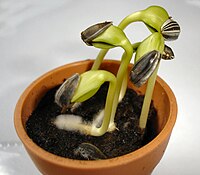
Photo from wikipedia
The root is the main organ of a plant for absorbing resources and whose spatial distribution characteristics play an important role in the survival of seedlings after afforestation. Chinese fir… Click to show full abstract
The root is the main organ of a plant for absorbing resources and whose spatial distribution characteristics play an important role in the survival of seedlings after afforestation. Chinese fir (Cunninghamia lanceolata) is one of China’s most important plantation species. To clarify the effects of propagation methods on root growth and spatial distribution characteristics of Chinese fir trees, sampled trees cultivated by seed germination, tissue culture, and asexual cutting of Chinese fir were taken as the research objects. The root morphology, geometric configuration, and spatial distribution characteristics of different trees were analyzed. The influence of geometric root morphology on its spatial distribution pattern was explored by correlation analysis, and the resource acquisition characteristics reflected by the roots of Chinese fir trees with different propagation methods are discussed. The main results showed that the root mean diameter (1.56 mm, 0.95 mm, and 0.97 mm), root volume (2.98 m3, 10.25 m3, and 4.07 m3), root tip count (397, 522, and 440), main root branch angle (61°, 50° and 32°) and other geometric configurations of Chinese fir under seed germination, tissue culture and rooted cutting respectively, were significantly different, which resulted in different distribution characteristics of roots in space. Chinese fir seed germination had noticeable axial roots, and the growth advantage was obvious in the vertical direction. A fishtail branch structure (TI = 0.87) was constructed. The shallow root distribution of tissue culture and rooted cutting was obvious, and belonged to the fork branch structure (TI = 0.71 and 0.74, respectively). There was a tradeoff in the spatial growth of the root system of Chinese fir trees with different propagation methods to absorb nutrients from heterogeneous soil patches. A negative correlation was present between the root system and root amplitude. There was an opposite spatial growth trend of Chinese fir trees with different propagation methods in the vertical or horizontal direction. In conclusion, selecting suitable propagation methods to cultivate Chinese fir trees is beneficial to root development and the “ideal” configuration formation of resource acquisition to improve the survival rate of Chinese fir afforestation.
Journal Title: Plants
Year Published: 2022
Link to full text (if available)
Share on Social Media: Sign Up to like & get
recommendations!